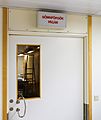Sleep disorder facts for kids
A sleep disorder is a problem that stops people from sleeping normally. But really what is normal sleeping? There are many sleep disorders, and some of them are very serious. A test commonly ordered for some sleep disorders is the polysomnogram.
Contents
Types of sleep disorders
Sleep disorders can be put into groups. These groups include:
- Dysomnia - these are sleep disorders which cause too much or too little sleep. Some of these are caused within the body while some are externally caused. For example, insomnia and narcolepsy are two of the dysomnias.
- Circadian rhythm sleep disorders - these cause sleeping at unusual times: too early, too late or not often. People with these disorders can usually get enough sleep, just at the "wrong" time of day. These disorders are sometimes included among the dysomnias. MeSH
- Parasomnias - these are doing things not normally done while sleeping, without the person being aware of what they are doing. They include walking, eating, dressing, bedwetting and other events.
- Medical or psychiatric disorders - these problems may also cause trouble sleeping. People with depression or alcoholism may sleep poorly.
(Sleeping sickness, a disease carried by the Tsetse fly, is not classified as a sleep disorder.)
Common sleep disorders
The most common sleep disorders include:
- Bruxism: grinding or clenching the teeth while sleeping
- Delayed sleep phase syndrome/disorder (DSPS): a circadian rhythm sleep disorder (see above): waking up and falling asleep much later than normal, but with no problem staying asleep
- Hatzfeldt Syndrome, or Systemic Neuro-Epiphysial Disorder (SNED): an irregular sleep pattern, as well as irregular behavior
- Hypopnea syndrome: abnormally shallow or slow breathing while sleeping
- Narcolepsy: falling asleep spontaneously and unwillingly at the wrong times
- Night terror disorder: sudden awakening from sleep showing fear or terror
- Parasomnias, see above
- Periodic limb movement disorder (PLMD): Sudden uncontrolled movement of arms and/or legs during sleep, for example kicking the legs. (Can seem like hypnic jerk, but hypnic jerk is not a disorder.)
- Primary insomnia, inability to get to sleep or stay asleep, not caused by any other disorder
- Rapid eye movement behavior disorder (RBD): acting out violent or dramatic dreams while in "rapid eye movement" (REM) sleep, also called dream sleep
- Restless legs syndrome (RLS): urge or need to move legs. People with RLS often also have PLMD.
- Shift work sleep disorder (SWSD)
- Sleep apnea (obstructive type): often waking suddenly when breathing stops, and usually loud snoring
- Sleep paralysis: temporary paralysis of the body shortly before or after sleep. Sleep paralysis may be accompanied by hallucinations of sight, hearing or touch. It is quite common.
- Sleepwalking: one of the parasomnias, see above
Common causes of sleep disorders
Changes in life style, such as shift work change or travelling over several time zones, can cause sleep disorders. Some other problems that can cause sleeping problems include:
- Anxiety
- Pain
- Environmental noise
- Various drugs and medications
- Hormone imbalance
- Circadian rhythm disorders
Treatment
A sleep diary or log can be used to help diagnose (define) the problem. It can also be used to measure improvements.
According to Dr. William Dement of the Stanford Sleep Center, anyone who snores and is sleepy in the daytime should see a doctor about sleep disorders.
In case of chronic pain, both the pain and the sleep problems should be treated. Pain can lead to sleep problems and vice versa.
The choice of a treatment for a sleep disorder depends on the patient's diagnosis, his/her medical and psychiatric history, and how she or he prefers to be treated. Medications sometimes work fast. On the other hand, sometimes behavioral treatment of insomnia may give more lasting results.
Images for kids
See also
 In Spanish: Trastorno del sueño para niños
In Spanish: Trastorno del sueño para niños


